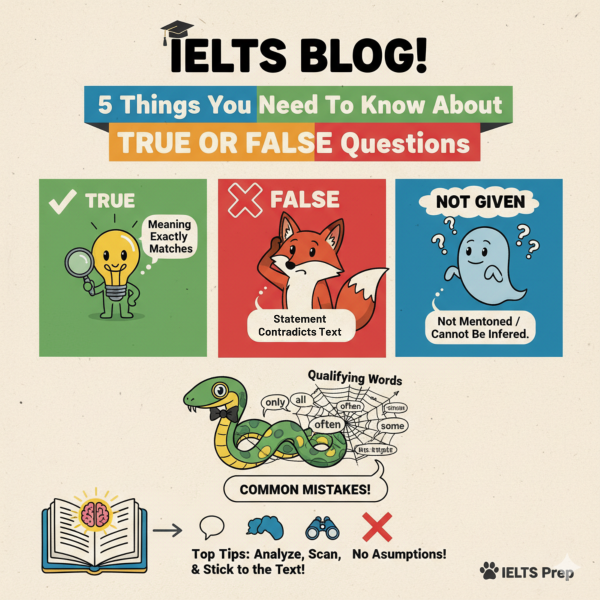IELTS True/False/ Not given question type falls under the Reading module of the IELTS examination and is also known as ” Identify information” section. This is a very tricky section and examinees get confused a lot on how to successfully answer this. We will try to address this problem in the following manner.
- In True/False exercises, if a statement is not true according to the text, it is classified as False. The statement can be false because it contradicts the information in some way.
- If the fact matches the reading, then it is True.
- If the fact is not mentioned or cannot be inferred in the reading, then it is classified under Not Given.
Common mistakes that a candidate make: A common mistake which students make is that if they find any statement similar to the information in the text, they think that the answer is “True”. This is incorrect as True means that the meaning is exactly the same. If it is just similar, then it is “False.” We are trying to deal with factual information here, so similar cannot be regarded as true. Many IELTS examiners try to mislead and deceive you by adding qualifying words such as mainly, all, often, some, occasionally and always.
Another important thing which you need to keep in mind is that there are certain statements which does not look like the information in the text at all, but still the answer is “True.” This can happen because the statement paraphrases sentences from the text or the information is not clearly stated in the texts. You have to delve deeper to infer the actual meaning from the text.
How to make out whether the statement is True/ False or Not Given in an accurate manner:
- The first and foremost thing is you have to analyse the statements correctly. Try to turn the statement into a question. You then try to answer it as Yes or No. If you cannot do that, the answer is Not Given.
- Try to search for words that qualify the sentence or make the sentence restrictive like only, little, not many, sometimes, usually, largely, etc.
- Look for words that have a negative connotation like ignore, refuse, deny, reject, or words that are positive like cover, help, like, favour, etc.
- Search for comparisons of any kind.
Some other essential tips for answering the True/False/Not Given questions correctly:
- You must read the statement carefully until you fully understand its meaning.
- Skim and scan the reading passage to find the associated information. Keep in mind that the question statements probably paraphrase or use synonyms rather than exact same words in the text. Use your pencil to mark down the statement number.
- Once the answer has been found, read the text carefully to determine whether the answer is True, False or Not Given. This is the most difficult part.
- If you are unable to find the correct information, then the information is most probably not given. Don’t waste your time looking for something which is not there.
Let us try to demonstrate this with a simple example. “Grizzly bears usually begin hibernation in November and will get no water or nourishment. Around March or April, male grizzly bears usually come out of their den, whereas females emerge in late April or May. The first food a grizzly bear eats is the carcasses of animals that died during winter.” State whether the following statement is true, false or not given?
Male grizzly bears normally finish hibernating before the female of the species. The relevant sentence is “Around March or April, male grizzly bears usually come out of their den, whereas females emerge in late April or May. True: Does the sentence definitely and clearly say ” Male grizzly bears finish hibernation before females?” The answer is Yes! False: Does the sentence definitely and clearly say: ” Male grizzly bears do not finish hibernation before females”? The answer is No. So correct answer: True
Last but not the least, when you are going to attempt this section, do not make up your own answers- some students give an answer according to what they think the correct answer would be. This is totally a wrong approach. Only answer according to what is exactly written in the writing passage.






